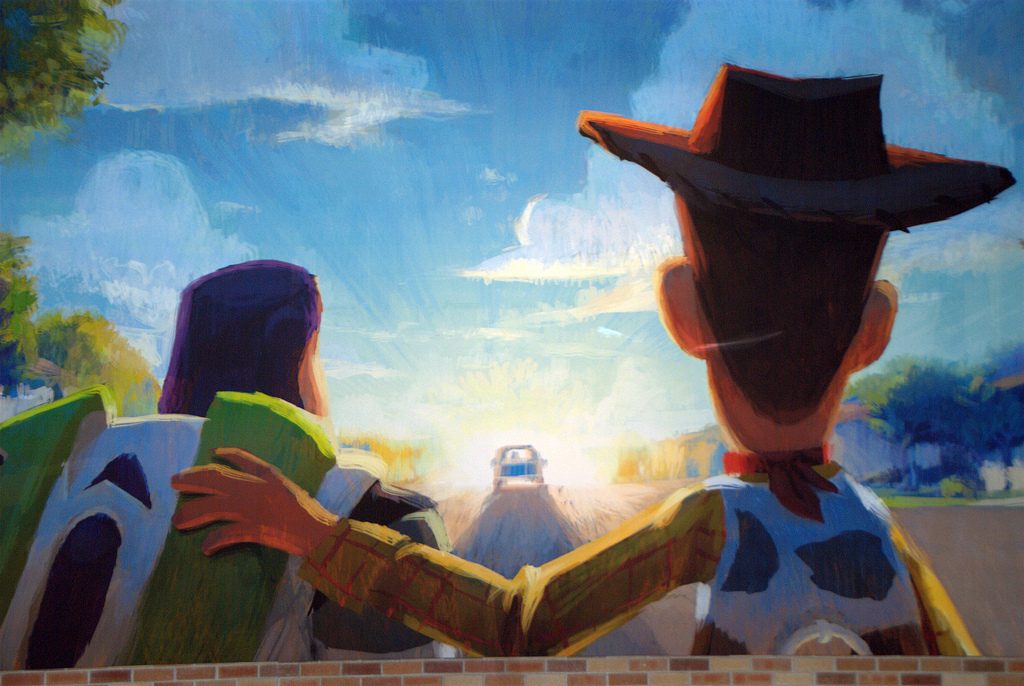Winner of the Fall 2018 StMU History Media Award for
Article with the Best Title
Best Article in the Category of “Cultural History”
“It felt like it had taken a lifetime to get to this point, and in a sense it had.”1
Most of us grew up in a world where toys came to life when Andy wasn’t looking, a world where the monsters in our closet were afraid of us, a world where houses could fly with balloons. Pixar movies have created a world of magic and infinite possibilities. They have brought life and authenticity out of technology. Pixar has created a cinematographic empire like no other. Their success was forged out of mistakes and struggles as well as passion, creativity, and determination. Pixar had to make mistakes in order to grow and create the stories we love today, and they did.
Pixar’s story really starts with three men: Edwin “Ed” Catmull, Steve Jobs, and John Lasseter.

Ed Catmull was turned down for a teaching position and felt he had landed a software development job with no future. Steve Jobs had been humiliated throughout Silicon Valley when Apple Computer, the company he founded, fired him.2 John Lasseter was fired from his dream job as a Disney animator for trying to introduce three-dimensional animation technology there. He was told that if it didn’t make movie production cheaper or faster, it wasn’t worth it.3 All of these men were at a low point in their lives when they became part of the group of people that eventually became Pixar. What brought them out of this uncertain part of their lives was a single goal: to change the way stories are told by pushing the boundaries of what computers can do in animation and graphics by creating the first computer-animated movie in history. These people became the foundation of Pixar Animation Studios.
Not commonly remembered is the company’s inception as the Computer Graphics Division for Lucasfilm, the movie studio behind the Star Wars franchise, beginning in 1979. Through a series of events, Steve Jobs ended up buying this small struggling division in 1986 for five million dollars. He also gave it its iconic name. At that point, the company was selling computer hardware with the Pixar Image Computer as their main product. Their increasingly dwindling revenue also consisted of producing commercials for companies such as Trident and Listerine.4 With their financial struggles, and no clear path into the future of movie-making, Pixar was created.
Pixar’s goal moved further out of reach as they fired one-third of the company in 1991. At that point, Pixar had only sold three hundred Pixar Image Computers. They then decided to stop selling hardware. The five million dollars it had cost Jobs to buy the company had turned into a $54 million money pit. Its only source of revenue, and future survival, was a contract with Disney to produce three movies. There wasn’t even a guarantee that they could make the movies. Nevertheless, the team decided to take a leap of faith into the unknown path of creating computer-animated movies.5
Money was tight and there was constant miscommunication between the Pixar team and Jobs. Jobs was in the middle of establishing NeXT, a computer company he started after Apple. This meant that he rarely appeared in the Pixar offices. The Pixar team felt Jobs did not understand what they needed, and Jobs felt that the Pixar team had no idea how to run a business. Lasseter and Catmull would put out an idea and Jobs would shut it down immediately: the only way was his way. Jobs was described as brilliant and inspirational as well as dismissive, condescending, and bullying. It was clear, Pixar could not survive under Jobs. He simply did not connect with the company leadership and staff, but the company could not survive without him either.6

From the year 1987 to 1991, Jobs attempted to sell Pixar three times. Catmull reflected on this time, saying, “Even if Pixar doubled in value, Steve told me, we still wouldn’t be worth anything.”7 Microsoft, Alias, and Silicon Graphics all tried to acquire the company, but Jobs never sold it. Despite taking millions of dollars of his own money just to keep it afloat, he could not sell. It was his way of saying that he had something other people wanted, something special, that Pixar was worth having, despite its flaws. Every time a company made an offer for Pixar, he acted insulted, suggesting that he believed Pixar was worth much more. It was only after critics predicted that an animated film would be a hit and that Disney signed with Pixar to make their movie, that Jobs gave Pixar one last chance.8
There emerged some hope, as they assembled an excellent but inexperienced team in 1992. Catmull and Jobs began to understand each other and collaborate, and the first computer-animated movie was in its beginning stages. Production of the movie began in early 1993. Their dream was so close that they could see it; their dream was becoming a reality. Their first movie blossomed from Lasseter’s simple idea, the story about a group of toys and a boy.9
Toy Story was going to create a revolution within the technology, art, animation, and entertainment fields. Because this was going to be their debut film under their “mentor” company Disney, Pixar story writers took every advice they gave them to heart. Disney animators were the experts, and they had the success Pixar craved. Disney perceived Woody, a toy cowboy and one of the movie’s main characters, as “too perky, too earnest.”10 An edgier Woody would create a better conflict and a better story. Or so they said.
November 19, 1993 came. It was also known as “Black Friday.” On this day, a mock-up of Toy Story was presented to Disney executives. Months of hard work had been dedicated to making this idea become a reality, and finally … Disney shut down the project. There would not be an animated movie until they fixed the script.
They had technology and talent, but the entire concept was just not right. Something crucial was missing. For the next couple of months Lasseter, Catmull, and the entire team worked every possible moment to rediscover the soul of the project. By this time, special effects were starting to enter mainstream cinematography, with movies such as Jurassic Park and Terminator 2. People enjoyed the manner in which technology enhanced the movie experience, and Pixar was ready to be part of this innovation wave.

The answer to their story problem was simple. They hit on the idea of a story of a boy and his toy cowboy. This experience taught them to trust their own abilities, to give Pixar its own character, and to do things the Pixar way.11
November 22, 1995. Toy Story was released to the world, to infinity and beyond.12
In total, Toy Story earned $362 million worldwide, it was a phenomenon. It had created an ingenious and creative new storytelling method. Now the graphics on the movie screen were perceived as having emotion and character. The movie had characters that had life in a way that was unprecedented from anything animators had done before. Pixar was able to create this emotional response because the overall theme was so human and relatable. With themes such as friendship, change, finding who you truly are, and your purpose in life, it is no surprise that though this movie was made for a young audience, it resonated with people of all ages. It was a masterpiece.13
The following year, Toy Story was nominated for three Academy Awards. John Lasseter received a Special Achievement Award. And Pixar announced its retirement from making commercials in order to focus on making more movies.
Due to its success with Toy Story, Disney pursued a partnership with Pixar. Shortly afterward, Pixar decided to open their company stock to the public. With this, they earned $140 million for the company. Pixar had accomplished something it had never done before; it was now a stable company.14
What started off as a constantly struggling company became an animation empire. Their stories have since touched the lives and hearts of people around the world. They’ve made us cry and they’ve made us laugh. Ed Catmull, Steve Jobs, and John Lasseter came together to change the world by creating the first computer-animated movie.
The rest is history.
- Edwin Catmull and Amy Wallace, Creativity, Inc.: overcoming the unseen forces that stand in the way of true inspiration (New York: Random House, 2014), 56. ↵
- David A. Price, The Pixar Touch: The Making of a Company (New York: Vintage Books, 2009), 8. ↵
- Bill Capodagli and Lynn Jackson, Innovate The Pixar Way: Business Lessons from the World’s Most Creative Corporate Playground (New York: McGraw-Hill, 2009), 31. ↵
- “Our Story,” Pixar, accessed August 31, 2018, https://www.pixar.com/our-story-1#our-story-main. ↵
- Edwin Catmull and Amy Wallace, Creativity, Inc.: overcoming the unseen forces that stand in the way of true inspiration (New York: Random House, 2014), 53. ↵
- Edwin Catmull and Amy Wallace, Creativity, Inc.: overcoming the unseen forces that stand in the way of true inspiration (New York: Random House, 2014), 51-52. ↵
- Edwin Catmull and Amy Wallace, Creativity, Inc.: overcoming the unseen forces that stand in the way of true inspiration (New York: Random House, 2014), 54. ↵
- Edwin Catmull and Amy Wallace, Creativity, Inc.: overcoming the unseen forces that stand in the way of true inspiration (New York: Random House, 2014), 53; “Our Story,” Pixar, accessed August 31, 2018, https://www.pixar.com/our-story-1#our-story-main. ↵
- Edwin Catmull and Amy Wallace, Creativity, Inc.: overcoming the unseen forces that stand in the way of true inspiration (New York: Random House, 2014), 54. ↵
- Edwin Catmull and Amy Wallace, Creativity, Inc.: overcoming the unseen forces that stand in the way of true inspiration (New York: Random House, 2014), 57. ↵
- Edwin Catmull and Amy Wallace, Creativity, Inc.: overcoming the unseen forces that stand in the way of true inspiration (New York: Random House, 2014), 57. ↵
- “Our Story,” Pixar, accessed August 31, 2018, https://www.pixar.com/our-story-1#our-story-main. ↵
- David A. Price, The Pixar Touch: The Making of a Company (New York: Vintage Books, 2009), 151. ↵
- Edwin Catmull and Amy Wallace, Creativity, Inc.: overcoming the unseen forces that stand in the way of true inspiration (New York: Random House, 2014), 60. ↵



201 comments
Nathan Alba
I thought this article was well written. I agree I think we can all remember the animation studio we grew up to love, but I don’t think many of us knew how the studio started off on such unstable ground. Who knows how different the culture could have been today if Pixar wasn’t required to make those 3 movies for Disney. Also, I had no idea Steve Jobs was involved in Pixar at all. That guy was either a genius or somehow got extremely lucky.
Dinorah Perez
Such an amazing article. Well written and brings light to all the struggles and determination of these people. Such an inspiration to know that when life brings you down you can pick yourself up and be successful.
Alyssa Garza
This is an interesting article I never knew that Pixar went through hard times keeping their company afloat. Pixar has bought so much happiness to everyone with their amazing movies with a mean full message behind them. I never even knew that the company sold hardware or worked on commercials. Toy Story is an amazing movie I still watch it till this day with my younger brothers and sister.
Jennifer Salas
I love Pixar and the Toy Story movies are my favorite, it was interesting to see how Pixar started and how it became so successful. I didn’t know Steve Jobs had helped Pixar get to where it is today by investing his own money. So many people enjoy the Pixar films including myself, so I’m glad that they never gave up even when it seemed that they wouldn’t make it.
Robert Freise
This article reminded me of my childhood. This company really wanted to have kids enjoy the story they produced. Some of the most iconic kids films and fiction based cartoon movies where filmed by Pixar. I did not know that Steve Jobs was affiliated with Pixar. Pixar for me was very influencial on what type of movies I watched as a young kid. This article gave me a better sense of the history of pixar and all the important people that were involved in making it.
Mariah Garcia
Pixar has told many stories through their works by the story line, characters, and morals in the story. I have and will always be fond of Pixar movies from all the sequels of Toy Story, Monsters Inc., UP, etc. But, I wasn’t aware that Toy Story was like the saving grace for Pixar. Pixar, like all other major companies, had their hardships and financial issues. But, through all the miscommunication and Steve Jobs condescending ways, each partner and worker pulled through until the very end and all their hard work payed off. It is such a beautiful story because Pixar has many movies that deal with hardship and loss of hope, but in the end the issues are resolved; their is a beautiful and touching ending that leave every viewer full of hope and joy.
Michael Hinojosa
While my sister and I grew up watching Pixar and have seen every single Pixar movie up to date I had no idea on the actual history of the company other than the fact that Monsters Inc and Toy Story were their starting films and their major successes as well. Embarrassing to say but even though I love Pixar and the movies they create I didn’t even know who the founders of the company were! So it was interesting to see Steve Jobs here in this article!
William Ward
Even as I mature into adulthood, I am a huge fan of pixar even to this day and enjoy the vast majority of the work they do. I did not know much about the story of pixar, but especially that Steve jobs was involved in such a way. Great title for this article and it is very well writen and enjoyable. Nice work!
Madison Downing
I have known the history of Pixar since I was a little child because of how much I loved Toy Story and Moster’s Inc. It was like walking down memory lane when reading your article because I remember sitting by my mother’s computer and researching the movies and who made them. Steve Jobs was a unique person who was fiercely independent but I loved how he never gave the company up and used his own personal money to keep it operating even when people would tell him it was a lost cause. They never gave up and now they will be forever written in history, you did a great job and I loved your article!!
Christopher Vasquez
I was not aware of the struggles that Pixar had faced with its creation. I also was not aware that Steve Jobs had his hand in the creation of Pixar, or that the company itself sold hardware and worked on commercials. Learning how Jobs managed — brilliantly and condescendingly — shed some light on him that I never considered. It’s unfortunate that people didn’t give them a chance they deserved at the beginning; however, Pixar’s time would come with Toy Story.